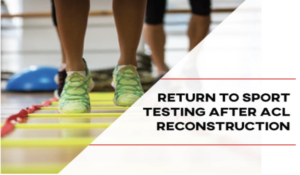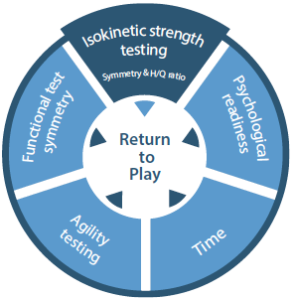
(Image source: https://theprehabguys.com/acl-return-to-sport-testing/)
After surgery, patients become apprehensive to return to the sport they love and recoup their pre-injury state of performance. Alongside, allowing a patient to return to their pivoting sport(s) is a critical and crucial decision for the orthopaedic surgeon as well. Various factors need to be taken into consideration before suggesting a patient to return to the pre-injury state of physical activity.
Our human body is a highly complex machine which functions well when it engages in physical activities and sports. But if it suffers a physical injury, it reacts in different manners ranging from individual to individual and situation to situation. In order to allow proper recommencement of sports activity, the human body must be restored to a healthy condition.
While it is generally assumed that the patients expect speedy return, it has been acknowledged that expectations may change once the ACL reconstruction surgery is undertaken. This change is caused due to a multitude of factors associated with the patient’s internal and external forces.
However, the proportion of patients who successfully resume their sports activity is relatively less as compared to the proportion of second ACL injury in athletes.
There is no established timeline or protocol for ACL rehabilitation but adequate time must be provided to the patient to experience healing from the surgery. Several studies highlight the time span of ACL rehabilitation including a healing period of up to 6 to 12 months depending upon the type of sport played, intensity of physical activity involved, ability to perform, the patient’s additional injuries and most importantly his or her will to make a comeback.
Even when athletes do return to their previous sport, often they do not return to their previous level of activity.

(Image source: https://www.iprsmediquipe.com/news/new-next-generation-isokinetic-software-advantage-bx/)
Factors affecting ACL reconstruction recovery
Various intrinsic and extrinsic factors affecting an athlete’s return on the playing field are
-
- Self-efficacy
It involves a person’s belief in his/her capabilities to execute behaviour necessary for accomplishing specific outcomes. Self-efficacy acts as a bridge between competitive anxiety and sports performance, thus helping in providing a stress coping mechanism.
Higher levels of self-efficacy results in quick recovery and rehabilitation. Additionally, it is a proven indicator of improved performance.
-
- Biological response
Genetic makeup of every individual varies and thus the biological response to one’s injury.
Lack of attention to the affiliation of graft and biological elements can result in inadequate outcomes. It is well-known that the graft has a slow maturation process which may be extended beyond two years. Thus, ample time must be provided to the patient so as to ensure full completion of the maturation process before permitting activities that could exert tension on the immature graft.
-
- Psychological attitude
It sometimes happens that even if the surgeon has shown a green signal still the athlete may not be mentally prepared to make a comeback due to fear, anxiety and frustration.
Psychological distress may delay a patient’s healing process. Therefore, having a positive attitude towards one’s recovery plays a dominant role.
-
- Type of graft
This is one of the most controversial aspects that affects the patient’s return to the sport after surgery.
In athletes, an anterior cruciate ligament (ACL) reconstruction is recommended to repair a torn ACL and regain stability so as to return to previous sport activity. Each type of graft has its own advantages and disadvantages and none can be termed as the ideal choice.
However, the most commonly chosen grafts for replacement of a torn ligament are allograft, patellar tendon and hamstring.
The graft tissue used in the reconstruction process undergoes three major processes namely, early healing, proliferation and maturation phase. Thus, the graft tissue used must possess the ability to withstand the pressure of extensive physical activity.
-
- Technique of surgery
The surgical technique used also affects the return-to-sport phase of the patient.
Despite various non-surgical techniques available, the surgeon may recommend surgical treatment. A method or technique may prove beneficial or detrimental depending upon case-to-case and individual-to-individual. Sometimes, surgical complications may result in long-term effects.
-
- Age
Age is another factor which cannot be neglected when evaluating the recovery period of a patient.
ACL recovery and rehabilitation complication rate increases with increase in one’s age. The level of stamina, immunity as well as motivation of an individual may lower, impacting the post-operative recovery phase.
Conclusion
As per the above mentioned points, there is no perfect time frame as to when a patient should join prior sports activity after ACL reconstruction surgery. After consulting with the orthopaedic surgeon and completing an appropriate healing period, when the patient feels the physical and mental strength to resume playing the sport, he or she must return to it.
Book your appointment with Dr. Rahul Grover today at https://glyraorthopaedics.com/
